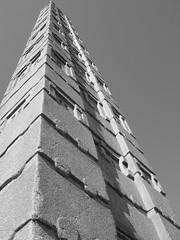 We arrived in Axum around 2pm, close to five hours late. When we arrived someone was, for the first time, checking passports. Now I had actually left my passport at the Indian Embassy in Addis to get my visa for India, but had been assured by my travel agent that I would have no problem as long as I had a photo ID and that had so far been true. When I handed my Colorado drivers license to the man checking passports (who seemed to be more interested in the covers than the content) he was dumbfounded of course. He's saying 'passport! passport!' and by this point patience has run out and I start yelling back, probably not the wisest course of action but after a few mins he ran off to some superior somewhere and came back and allowed me into the airport.
We arrived in Axum around 2pm, close to five hours late. When we arrived someone was, for the first time, checking passports. Now I had actually left my passport at the Indian Embassy in Addis to get my visa for India, but had been assured by my travel agent that I would have no problem as long as I had a photo ID and that had so far been true. When I handed my Colorado drivers license to the man checking passports (who seemed to be more interested in the covers than the content) he was dumbfounded of course. He's saying 'passport! passport!' and by this point patience has run out and I start yelling back, probably not the wisest course of action but after a few mins he ran off to some superior somewhere and came back and allowed me into the airport.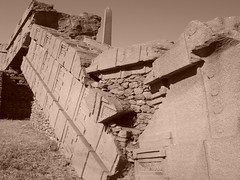 Despite being so late my guide, Haile Selassie, was determined to make the most of things. We dropped my bag at the hotel and were off to the 'Stelae Field' where all of the giant obelisks reside. When he picked me up at the airport I wasn't too sure about Haile, but he turned out to be my best guide yet. He gave me the history of the obelisks, why they were made, by whom etc...unfortunately, because he wanted me to see as much as possible, he refused to let me stop and take notes so almost all of the details are gone, but it sure was fascinating at the time. Haile was also the most photo happy of the guides (to the extent of snatching my camera from me on several occassionas), wanting to make sure he got pictures of me next to and in front of the main obelisk, in the stone frame, at the entrance to a tomb, inside the tomb, by the broken obelisk, etc. I think I have more photos with me in them from that afternoon than from the previous 6 months combined. One fact I do remember from that afternoon is that the broken obelisk is the largest single block of stone ever worked at a height of close to 38 meters and weighing close to 500 tonnes.
Despite being so late my guide, Haile Selassie, was determined to make the most of things. We dropped my bag at the hotel and were off to the 'Stelae Field' where all of the giant obelisks reside. When he picked me up at the airport I wasn't too sure about Haile, but he turned out to be my best guide yet. He gave me the history of the obelisks, why they were made, by whom etc...unfortunately, because he wanted me to see as much as possible, he refused to let me stop and take notes so almost all of the details are gone, but it sure was fascinating at the time. Haile was also the most photo happy of the guides (to the extent of snatching my camera from me on several occassionas), wanting to make sure he got pictures of me next to and in front of the main obelisk, in the stone frame, at the entrance to a tomb, inside the tomb, by the broken obelisk, etc. I think I have more photos with me in them from that afternoon than from the previous 6 months combined. One fact I do remember from that afternoon is that the broken obelisk is the largest single block of stone ever worked at a height of close to 38 meters and weighing close to 500 tonnes.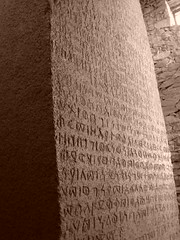 Another nugget of information from Halie was that before Ethiopia was a country it existed as part of the kingdom of Axum with consisted of modern day Sudan, Ethiopia and Yemen and was ruled by one king. That king had three sons and split the kingdom up into what are effectively Ethiopia/Eritrea, Sudan, and Yemen today to be ruled over by each of the three sons. From the the Stelae field we headed to a tomb for the first king of Ethiopia, a tomb that contains a 'treasure vault' that still hasn't been opened. One of the things that was amazing about Axum is that a lot of the history there seemed to be quite newly discovered. There were several occassions where I was told that such and such was just discovered a few months ago. Apparently there are at least a dozen archaeological digs currently going on by teams from German, France, England, and the US, and it seems like even with those they are just scratching the surface. One of the things that was discovered only ten months before by three farmers while plowing and only raised out of the ground three months before was a giant stone tablet, apparently similar to the 'rosetta stone' in Egypt, that has the story of some king written in three different languages.
Another nugget of information from Halie was that before Ethiopia was a country it existed as part of the kingdom of Axum with consisted of modern day Sudan, Ethiopia and Yemen and was ruled by one king. That king had three sons and split the kingdom up into what are effectively Ethiopia/Eritrea, Sudan, and Yemen today to be ruled over by each of the three sons. From the the Stelae field we headed to a tomb for the first king of Ethiopia, a tomb that contains a 'treasure vault' that still hasn't been opened. One of the things that was amazing about Axum is that a lot of the history there seemed to be quite newly discovered. There were several occassions where I was told that such and such was just discovered a few months ago. Apparently there are at least a dozen archaeological digs currently going on by teams from German, France, England, and the US, and it seems like even with those they are just scratching the surface. One of the things that was discovered only ten months before by three farmers while plowing and only raised out of the ground three months before was a giant stone tablet, apparently similar to the 'rosetta stone' in Egypt, that has the story of some king written in three different languages.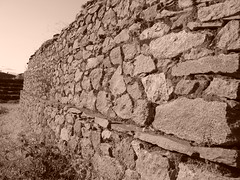 From the 'Axumite Rosetta Stone' we headed to the alleged ruins of the palace of the Queen of Sheeba. I say alleged because a guide book I glanced at seemed to indicate that it was at least several hundred years to new for that, but either way it was an interesting place. What was most interesting was that it was built almost entirely of rubble, meaning that hardly any cut stone was used. I had seen this in other walls but this was the first time I'd see an entire building, let alone palace, constructed this way. Of course Haile had to get a few pictures of me at the palace: leaning against a wall, where the throne was, at the top of some stairs.
From the 'Axumite Rosetta Stone' we headed to the alleged ruins of the palace of the Queen of Sheeba. I say alleged because a guide book I glanced at seemed to indicate that it was at least several hundred years to new for that, but either way it was an interesting place. What was most interesting was that it was built almost entirely of rubble, meaning that hardly any cut stone was used. I had seen this in other walls but this was the first time I'd see an entire building, let alone palace, constructed this way. Of course Haile had to get a few pictures of me at the palace: leaning against a wall, where the throne was, at the top of some stairs.Photos: Axum
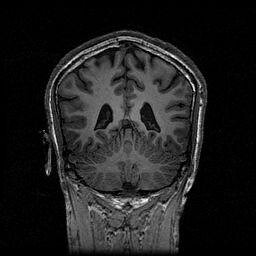
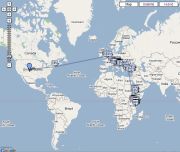






No comments:
Post a Comment